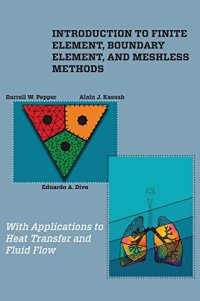
Ebook: An introduction to finite element, boundary element, and meshless methods with applications to heat transfer and fluid flow
Author: Divo Eduardo A., Kassab Alain J., Pepper Darrell W
- Tags: Fluid dynamics, Mathematical models, Heat, Transmission, Mathematical models, Finite element method, Boundary element methods, Meshfree methods (Numerical analysis), TECHNOLOGY & ENGINEERING, Hydraulics
- Year: 2014
- Publisher: American Society Of Mechanical Engineers
- Language: English
- pdf
When students once master the concepts of the finite element method (and meshing), it's not long before they begin to look at other numerical techniques and applications, especially the boundary element and meshless methods (since a mesh is not required). The expert authors of this book provide a simple explanation of these three powerful numerical schemes and show how they all fall under the umbrella of the more Read more...
Abstract: When students once master the concepts of the finite element method (and meshing), it's not long before they begin to look at other numerical techniques and applications, especially the boundary element and meshless methods (since a mesh is not required). The expert authors of this book provide a simple explanation of these three powerful numerical schemes and show how they all fall under the umbrella of the more universal method of weighted residuals. The book is structured in four sections. The first introductory section provides the method of weighted residuals development of finite differences, finite volume, finite element, boundary element, and meshless methods along with 1D examples of each method. The following three sections of the book present a more detailed development of the finite element method, then progress through the boundary element method, and end with meshless methods. Each section serves as a stand-alone description, but it is apparent how each conveniently leads to the other techniques. It is recommended that the reader begin with the finite element method, as this serves as the primary basis for defining the method of weighted residuals. Computer files in both MathCad and MATLAB are available from the fbm.centecorp.com website, along with example data files